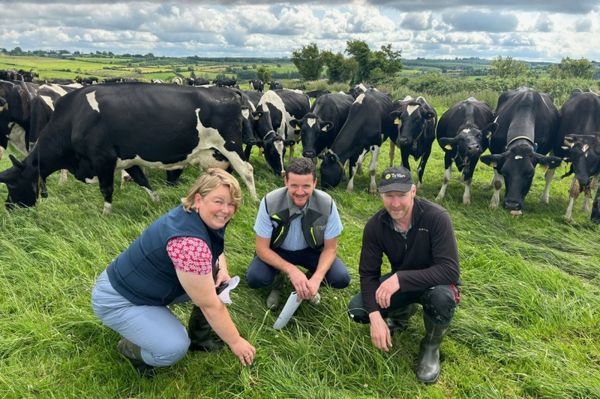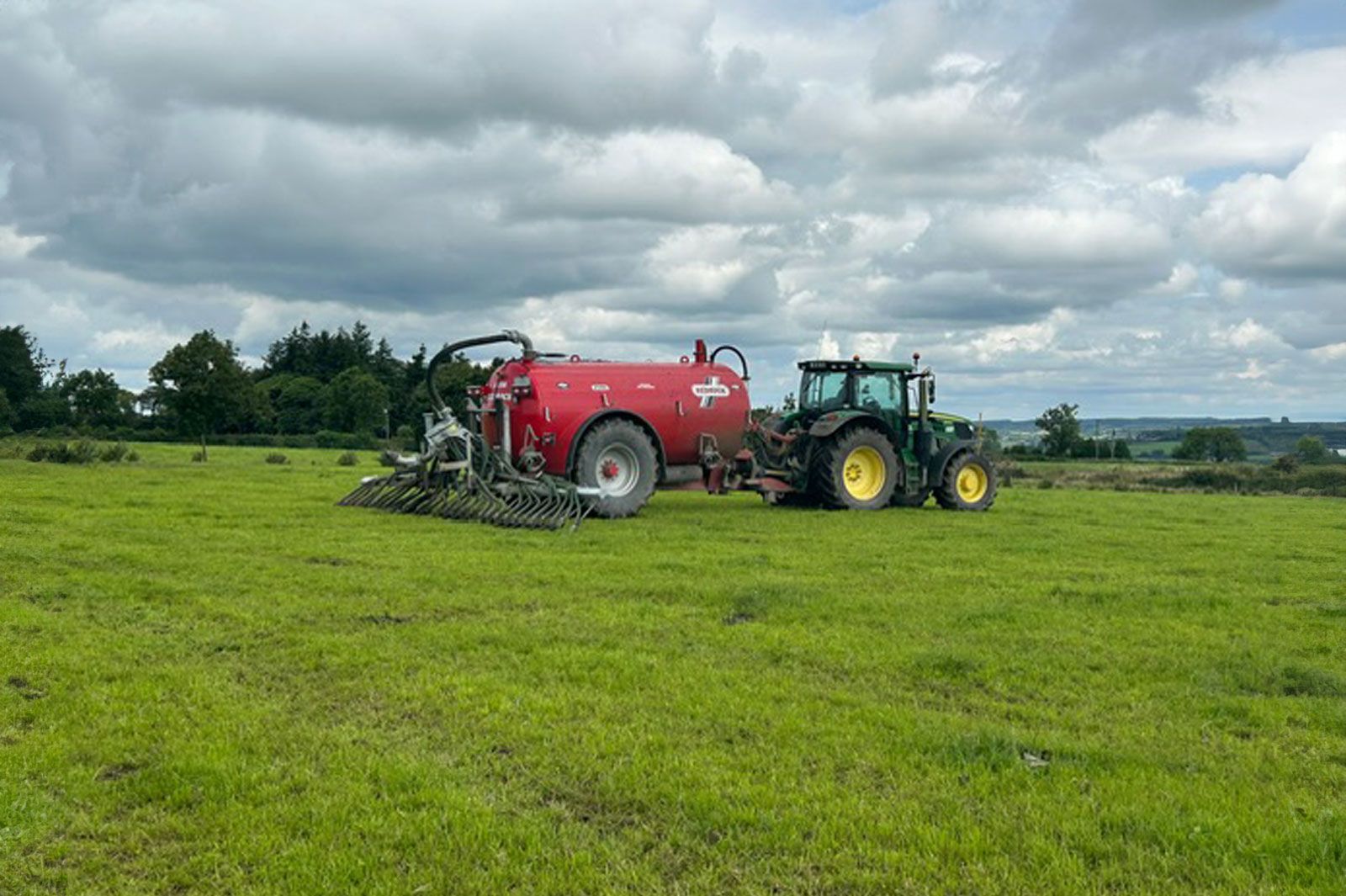High and low tech delivering the goods

The field margins on Francis Nolan’s farm are noteworthy. Apart from the fact that the hedgerows are managed over a three-year cycle, they are also fenced off from the paddocks. Likewise, the watercourses that are a regular feature of the landscape on the farm are fenced and managed to optimise the growth of biodiverse plant species with minimal impact on grazing space for the cow herd. Francis explains: “There’s a buffer along where we put new watercourses to dry out the fields a bit. We’ve allowed grass and wildflowers to grow inside that buffer. We don’t cut it, it’s just there, and the cows graze as far as they can, that’s it. Grass and vegetation that’s growing behind the wire between the field and the stream is filtering and buffering any nutrient run-off from the land. We’re not losing much so it doesn’t impact economically on farm production. If it stops the sediment going in, we’re willing to do it.”
Sandra Hayes, Teagasc environment specialist, affirms Francis’s view of field-edge buffering: “There isn’t an issue in that sort of practical approach to preventing run-off. In most cases, it’s single strand electric keeping the animals out of the watercourses. You’re stopping the sediment with the grass and plants that have grown up.
"In addition, the farmer doesn’t have to clean out drains because animals are not getting into them. The banks are more solid, and the cows can graze under the wire without eroding the bank.”
Roadway restructuring
Francis reviews the roadway restructuring that he undertook: “Previously, they were following hedges and watercourses. Three years ago, we changed the routes to improve cow flow and protect water quality. We constructed a central road through the farm and eliminated routes along watercourses. We also eliminated a lot of turns for cows and shortened distances for walking. The aim is to get the cow from the milking parlour to the grass, and vice versa, as quickly and as smoothly as possible.”
The new roadway structure, according to Sandra, removed six unnecessary turns for cows walking to and from the parlour: “The benefit is more time spent in the paddock.”
Nitrogen fixing
Francis says clover is becoming more prevalent on the farm: “We have been adding clover to the sward since 2019. In the last few years, we’ve cut back nitrogen on the clover fields to promote the clover. This year has been a struggle in terms of growing grass, so we have kept up fertiliser application across the farm generally.”
Sandra adds: "It’s not only grass growth. Clover has been impacted by sub-optimal growth rates. We’ve been clover scoring on this farm and the other monitor farms since last April. This year, we’ve seen the cumulative effect of lots of impacts. Heavy covers carried over because ground didn’t get grazed out can smother the clover and then, due to the very poor spring, there was some poaching on farms. Lower air and soil temperatures also contributed to lower clover growth. Farmers had to fill the gap with chemical nitrogen because the clover plant didn’t fix as much as usual. Clover needs plenty of care, heat and dry weather.”
The chemical nitrogen of choice is protected urea on the Nolan farm: “It’s been all protected urea for the last couple of years. Growth, in general, was back this year but I wouldn’t put it down to the type of nitrogen used,” says Francis.

When Francis spreads chemical fertiliser, the boundary from the watercourse is three metres.
Managing high-risk areas
Tirlán’s TJ Phelan was a participant on the Nolan farm walk. He highlighted several of the important aspects around protecting water quality and encouraging biodiversity on the farm: “Francis and Sandra have referenced the clover and the nitrogen strategy on the farm. If I look at the pollution impact potential (PIP) maps for Francis’s farm, I can identify the high-risk areas. Parts of the farm are identified as being at higher risk of nitrate leaching. Down towards the river the land is heavier. The actions that Francis is taking in relation to clover on the farm, resulting in lower nitrogen requirement in those fields, minimise the potential for nitrates leaching. Despite this, Francis grew 13 tonnes of grass per hectare last year on the milking platform. Optimising soil fertility is a big part of it and that has allowed more grass to be grown from a lower nitrogen input. There’s a nutrient management plan in place to monitor and optimise input requirements. While some of the swards are relatively new, there are 10-year-old swards still performing well on the Nolan farm.”
Maintaining the buffer zones is important, Sandra emphasises: “When chemical fertiliser is spread, the boundary from the watercourse is three metres. That ground can still be grazed but the nutrients can’t get to the watercourses. With slurry, your normal boundary is five metres.”
Critical investments
Francis lists critical investments that have improved efficiency and lowered emissions: “I bought a trailing shoe slurry tanker two years ago. That has allowed me to manage slurry better, with less waste and better application timing. I find it a very good job. We get a lot more use out of slurry in the summertime. We’re able to follow cows with watery slurry the whole time. It’s a big investment but there is a benefit. Back in 2020 we put up a new shed, with a large slurry tank. Now we have extra storage, over 30 per cent more than we require on paper.”
TJ Phelan agrees with the strategy: “Francis has over and above what’s required in relation to slurry storage. And I think he sees the benefit of that in terms of going out with slurry at the right time and getting the maximum benefit from it. There is a huge cost of putting up slurry storage and that’s an issue that needs to be addressed. Where we have the right supports, slurry facilities will be put in. There is a benefit in relation to derogation, optimising spreading dates and the risk of poor weather delaying spreading. Section controls on the fertiliser spreader are another example of an investment paying off for Francis. Overlapping and boundary spreading are avoided with greater fertiliser use efficiency generally.”
High-tech herd-health monitoring
Francis justifies his investment in cow monitors: “They’re great for heat and health monitoring. We are getting more accurate results every year as we understand the technology better. There is labour saving, even for drafting cows for AI or examination for health issues. The monitors improve profitability with an improved breeding pattern, earlier detection of health issues and lameness.”
High-performance figures
Adherence to best environmental practices hasn’t prevented the Nolan herd from delivering impressive production figures. Francis quotes milk solids of 530kg per cow last year. The herd starts to calve on January 20, going to grass in early to mid-February, weather allowing. With an average calving interval of 365 days, the aim is to optimise grass production and utilisation with a long grazing season.




